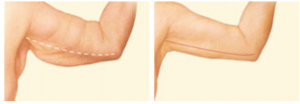Friday, February 8
What Is Arm Lift or Brachioplasty Surgery
What is an Arm lift or Brachioplasty?
Arms are often the forgotten parts affected by significant weight loss. They are however a common area for skin removal or lipectomy surgery. Dr Eddie Cheng, Specialist Plastic Surgeon based in Brisbane, QLD, regularly performs arm lift surgery and below you'll find some great information about this procedure.
An arm lift, or brachioplasty, is a surgical procedure that targets excess or sagging skin most commonly in the upper arm area. Changes in weight, ageing and genetics can cause your upper arms to have a drooping or sagging appearance. Often exercise alone cannot change the look of excess sagging upper arm skin.
Am I a good candidate for arm lift surgery?
In general, arm lift candidates have:
- -Significant upper arm skin laxity
- -A BMI of less than 30, in an ideal world a BMI between 20-25 is our goal
- -Good health with no conditions that may compromise healing and recovery
- -Quit smoking or a non-smoker
- -Individuals with a positive outlook and realistic expectations
What is the cost of an arm lift?
The cost of arm lift or brachioplasty surgery varies depending on the procedure and each patient's individual anatomy. On average Arm lift surgery with Dr Eddie Cheng starts from $6100 including:
- -Specialist Surgeon Dr Eddie Cheng's fee
- -Sleeve compression garment fee
- -Incision line care pack
- -Aftercare reviews with Dr Cheng our experienced plastic surgery Registered Nurse at week 1, week 3, week 6, 4-6 months and 12 months postoperatively
Anaesthetist and hospital fees are additional and can be provided at the time of your consultation. Medicare and private health insurance rebates may be apply and can be provided with your formal estimate at the time of consultation. When choosing a specialist plastic surgeon for an arm lift, remember that the surgeon's experience and your comfort with him or her are just as important as the final cost of the surgery.
Can I use my private health insurance?
You may be eligible for a medicare and health fund rebate for your weight loss surgery including arm lift procedures providing you meet certain medicare criteria. Dr Cheng will confirm your eligibility during your consultation, however, you can begin to check off the following:
- Obtain a referral from your GP that provides details about your SWL and other details outlined below
- Evidence of SWL (SWL is defined as a weight loss of at least 5 BMI units, a general guide for women is approximately 15kg or more), head to our BMI calculator to check!)
- Your weight has been stable for 6 months
- Evidence of skin conditions such as inflammation, chafing and rashes that have been treated with creams or similar for 3 months and failed to improve
- Redundant skin is interfering with activities of daily life.
- Contact your health fund to see if your policy has any exclusions for item number 30171
What should I expect during a consultation for arm lift surgery?
During your arm lift surgery consultation be prepared to talk to Dr Cheng about:
- -Your goals and concerns
- -Your motivations or reasons for having this surgery
- -Medical history and conditions including any allergies and previous surgery
- -Medications you are currently taking including vitamins, herbal supplements, alcohol, tobacco and drug use
- -Any health professionals you currently receive treatment from
During this consult Dr Cheng and your patient coordinator will also:
- -Take clinical photographs
- -Discuss how he performs the procedure
- -Discuss different treatment options relevant to your anatomy
- -Discuss recovery milestones such as surgical dressings and drains, time off work, return to normal activities such as driving and travel
- -Talk about the likely result of arm lift surgery based on your personal anatomy as well as outline risks and possible complications
Your consultation is a great opportunity to ask questions. Refer to our previous blog post about choosing the best plastic surgeon for me for a great list of questions to ask your surgeon. Before any surgery you will need to consult with Dr Cheng for at least one other consultation, usually your pre operative consultation.
How long does Brachioplasty Surgery Take?
The brachioplasty procedure is performed under a general anaesthetic and can take anywhere from 1.5-2.5 hours. Depending on the patient and where the excess skin sits. The incisions (and subsequent scars) will be made on the inner side of the arm from the elbow to the armpit to minimise visibility of the scar. The key aim of this procedure is to target the symptoms of excess skin and as well as keep an harmonious transition from forearm to armpit.”
What are the risks of arm lift surgery?
You will be asked to sign consent forms that outline general and specific risks of arm lift surgery to ensure you fully understand the procedure.
Arm lift surgery risks include:
- -Anaesthesia risks
- -Bleeding
- -Infection
- -Reaction to sutures, dressings and antiseptic solutions
- -Poor wound healing
- -Unsightly scarring
- -Restricted skin or tightened skin
- -Fluid accumulation (seroma)
- -Blood clot (haematoma) forming beneath the incision site
- -Complications such as heart attack, pulmonary embolism or stroke caused by a blood clot
- -Damage to deeper structures such as nerves, blood vessels and muscles
- -Fatty tissue under the skin might die (fat necrosis)
- -Numbness or other changes in skin sensation
- -Contour irregularities or uneven contour
- -Pain, which may persist
- -Sutures may not absorb, but spontaneously surface through the skin, causing irritation, drainage and redness
- -Possible need for revisional surgery
How should I prepare for arm lift surgery?
In preparing for arm lift surgery, you may be asked to:
- -Make sure you are in your best physical shape and at your goal weight for at least 6 months
- -Prepare to take 2-3 weeks off work depending on your occupation
- -Complete any blood tests
- -Stop certain medications based on Dr Cheng's advice. Specifically medications such as nurofen and aspirin and any herbals such as fish oil at least 2 weeks prior to surgery to limit the risk of bleeding
- -Stop smoking at least 8 weeks before and 8 weeks after your surgery, preferably quit forever!!
What are the steps of an arm lift procedure?
An arm lift procedure includes the following steps:
Step 1 - Planning and Anaesthesia
On the day of surgery, Dr Cheng will see you in the pre operative area to perform the important planning and marking for your surgery. Our anaesthetist may have already contacted you the night before your procedure, or you may meet and talk to your anaesthetist for the first time on the day of surgery. Anaesthetic medications are given for your comfort during arm lift surgery. Dr Cheng always performs arm lift surgery under a general anaesthetic and typically patients remain in hospital for 2-3 days. Arm lift surgery can also be performed as day surgery and same day discharge home.
Step 2 - The incision
Incision length and pattern during arm lift surgery depends on the amount and location of excess skin to be removed - Dr Cheng will discuss this with you at your initial and pre operative consultation and again on the day of surgery. Typically, Dr Cheng prefers incision lines on the inside of the arm. They may extend from the armpit (axilla) to just above the elbow. Dr Cheng may also perform liposuction to remove excess fat and improve arm contouring.
Minimal incision
Minimal incision may also be suitable for patients with less skin laxity.
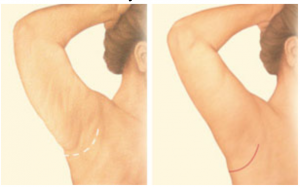
Step 3 - Closing the incisions
Your incision will be closed using several layers of dissolvable sutures which will not be visible on the outside. A transparent surgical tape will cover the incision lines and remain in place for 3 weeks. When you wake up in recovery, your arms will be bound with a compression bandage and you will have a small thin tube called a surgical drain in each incision line for several days following your surgery. This will help drain any excess fluid.
Step 4 - Early post operative recovery
Several days after surgery, your drains will be removed along with the outer compression bandage. You will see some bruising and swelling, however, your early results should be visible. Usually a smoother, more contoured arm is seen almost immediately after surgery. At this time you will be fitted with a sleeve compression garment which you will wear for 6 weeks. The transparent incision line tape will remain in place for 3 weeks following your surgery and yes you can shower as usual as this tape is waterproof.
Below is an example of the type of compression garment you will wear post operatively, which is why the cooler months is always a great time to have arm lift surgery.
Avoid excessive force and movement of the arms during healing. Dr Cheng and our very experienced plastic surgery nurses will provide written and verbal instructions on how to care for your incision lines at home. You will also see our team regularly during your early recovery period.
What should I expect during my arm lift recovery?
Each person's recovery will be slightly different depending on the complexity of surgery but generally you can expect the following during your individual recovery period:
- -Can I go home the same day after my arm lift? Yes.
- -What medication will I be given or prescribed after surgery? At your pre operative consultation Dr Cheng will arrange scripts in readiness for your post operative discharge. Scripts will include: pain relief, antibiotics, anti-nausea medication and movicol to relieve any constipation
- -Will I have dressings/bandages after surgery? Yes A transparent surgical tape will cover the incision lines and remain in place for 3 weeks. When you wake up in recovery, your arms will be bound with a compression bandage and you will have a small thin tube called a surgical drain in each incision line for several days following your surgery.
- -Will I have stitches? All sutures are dissolvable and are internal.
- -When can I get back to my normal activity and exercise after arm lift surgery? Gentle exercise such as walking 2-3 weeks, 6 weeks for upper body gym workouts
- -When will Dr Cheng see me for my aftercare? Anytime you need us but typically week 1, week 3, week 6, 4-6 months and 12 months.
- -Bruising and swelling may take several weeks to resolve and scars will take 12-18 months to mature and fade, however, you will notice improved arm contour almost immediately following your procedure.
How long will the results of arm lift surgery last?
Results are typically long lasting if you maintain a stable weight and fitness over time. Naturally ageing and genetics will play a part in the longevity of your results, however, improvement should be relatively permanent.
In some situations, it may not be possible to achieve optimal results with a single surgical procedure and sometimes more surgery may be necessary.
Arm Lift Before and After Photos
6 Weeks after Arm Lift By Dr Eddie Cheng
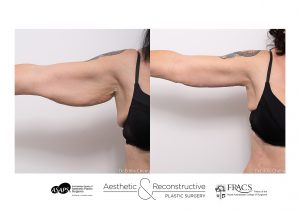
6 Weeks after Arm Lift By Dr Eddie Cheng
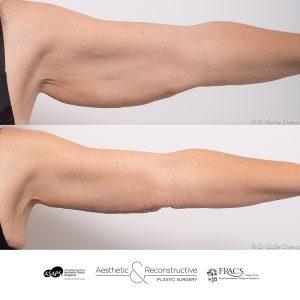
6 Weeks After Arm Lift By Dr Eddie Cheng
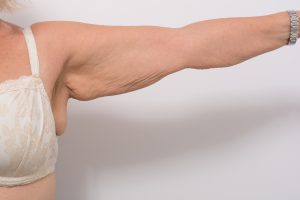
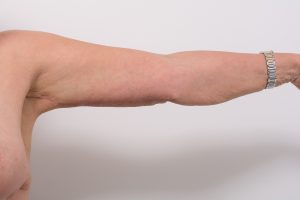
See more Arm Lift Before and After Photos
Terminology to know
Arm lift:
A surgical procedure, also known as brachioplasty, to correct sagging of the upper arms
Axilla:
The underarm area
Brachioplasty:
A surgical procedure, also known as arm lift, to correct sagging of upper arms
Liposuction:
Also called lipoplasty or suction lipectomy, this procedure vacuums out fat from beneath the skin’s surface to reduce fullness
Skin laxity:
Degree of loose skin
Sutures:
Stitches used by surgeons to hold skin and tissue together
Dr Eddie Cheng is a board certified Specialist Plastic Surgeon in Brisbane, Australia. Socialise with us @arplasticsurgery to learn more about Dr Eddie Cheng and our Team.

